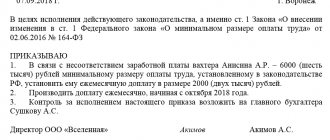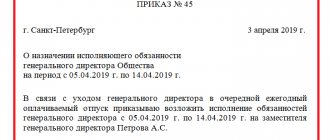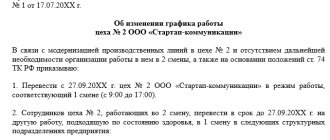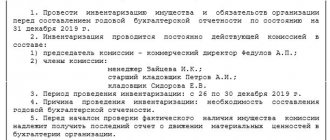Employers want employees to perform their duties well. But the needs of the enterprise change, and the functionality of employees has to be adjusted. Sometimes employees are forced to take on additional work, and not always in accordance with their specialization. Is the subordinate's consent required for additional duties? How to document this? Let's find out in this article.
The main employee went on sick leave. How to issue an assignment of additional work to perform his duties for another employee ?
Legislative regulation
When assigning additional responsibilities to an employee, one should rely on current legislative norms and internal documentation of the enterprise.
The list of responsibilities of each employee is determined by the terms of the employment contract, the elements of which must be reflected in the job description. When preparing documentation, you should take into account the range of responsibilities regulated by a particular profession and the qualification requirements for it.
If there is a production need to perform work that is not taken into account by the internal regulatory documentation drawn up for a specific employee position, it is necessary to make appropriate changes to it. To do this, it is necessary to adjust the documentation regulating labor relations.
Legal norms
The Labor Code defines the rights of each employee of a business entity to work in accordance with the requirements of a formalized agreement with the employer.
He is not authorized to assign additional duties to hired workers without obtaining their consent. To legally make changes to the documentation regulating changes in labor parameters, it is necessary to notify the employee in writing about the planned changes no later than 2 months before their implementation. Adjustments to duties can only be made after receiving the employee’s written consent after two months from the date of the event.
It is worth noting that if, when the list of works is changed, the employee’s functional responsibilities do not change, then the internal documentation of the enterprise can be changed without the consent of the employees. After the internal documentation has been completed and put into effect, employees must be familiarized with the list of obligations set out in the new edition.
Temporary transfer and combination: features
This translation is one of the most convenient design options in such situations. The timing of temporary transfers usually depends on the reason.
For example, you can establish that the performance of new duties ends when the main employee returns from vacation. In some cases, this does not even require consent from the employee. For example, when there is a general production need.
Combinations are usually formalized if key employees go on maternity leave or long vacations. This is where Article 60.2 of the Labor Code comes to the rescue.
It is assumed that the part-time worker performs both his main job and additional work. This period is usually also associated with the following concepts and phenomena:
- Recalculation of wages, upward.
- Significant expansion of the service area.
- Increasing the direct volume of work.
When additional responsibilities are necessary
Non-standard production situations that require additional obligations to be imposed on employees may be due to the absence of an employee from the workplace, whose responsibilities are transferred to the shoulders of other persons. The reasons for the event may be illness, vacation or medical examination. If the solution to a production problem is within the competence of a specialist who has a specific qualification, a specialty for which is not included in the staffing table, then such obligations can be assigned to an employee who has the appropriate education and skills.
Dependence of labor parameters and remuneration on the applied method of assigning additional responsibilities
An increase in the volume of product output, as well as changes in production regulations, may require additional work not previously provided for by the business entity. New responsibilities may be assigned to an employee within the limits of his competence.
It is important to correctly formalize additional responsibilities for the employee in order to eliminate later disputes regarding remuneration and incompetent performance of duties, which the employee may not be aware of.
Basic moments
Sometimes it happens that one employee holding one or another responsible position has to leave his workplace for a certain period of time. However, it goes without saying that his official duties cannot remain unfulfilled. This is especially important in cases where key positions are involved.
In this situation, the most correct solution would be to transfer responsibilities to another employee with a sufficient level of qualifications. At the same time, management, first of all, must decide for itself in what format the replacement of the missing specialist will take place. There are three options provided by law:
- full performance of the duties of the departing employee with temporary release from the previous ones;
- assignment of temporary additional functions as an additional load;
- inviting temporary specialists from outside.
How to assign additional responsibilities to an employee
In order to assign additional responsibilities to an employee, it is necessary to act in accordance with an algorithm, the implementation of which will help legally competently solve the production problems that have arisen:
- Drawing up notification of planned changes in working conditions and remuneration. The document must indicate the reason for the actions planned by the employer and the identifying information of the employee in respect of whom all measures will be taken. It is important to indicate the period for which changes are planned.
- Providing the document to the employee for review and signature, which will indicate his consent to work under the new rules.
- Amendments to internal regulations providing for the procedure for imposing additional responsibilities.
- Drawing up an additional agreement to the employment contract. It is recommended that the document reflect a list of imputed additional obligations and the period for which they will be assigned to the employee, as well as the procedure for remuneration. It can be determined as a payment of a fixed amount or as a percentage of a specific salary.
- Making an order.
Algorithm of actions
Step-by-step instruction
Whatever the reason why the manager is forced to begin personnel changes, for him it is always important and necessary for the effective operation of the enterprise. Competent management requires compliance with legal norms and the elimination of conflict situations in the company.
Therefore, you need to follow in strict sequence, applying the following points in actions:
- a memo is drawn up from a boss of lower status to a manager of a higher position, outlining the reasons that prompted the adoption of certain measures with the reshuffling of personnel;
- obtain approval of the issue from the management of the company;
- take a written decision from the employee to assume additional obligations;
- create and transmit to the personnel service an order about the changes that have occurred.
Please note that if an employee’s job functions have changed, an additional agreement will need to be created indicating:
- terms of presence in this position;
- performing certain actions;
- amount of payment;
- conditions for temporary proceedings for the period of validity of the order.
The order is drawn up on a general basis, assigning a serial number, recording it in a special book and sending copies to personnel and accounting. The employee is also required to sign the newly created document; this proves that he was aware of the changes that had taken place in time and fully agrees with them.
Additional responsibilities within one position
The main document regulating the duties of an employee is the Employment Contract.
Legislative norms do not determine the need to prepare a Job Description, so the presence of this document is not required. However, authorized bodies recommend the preparation of such organizational and administrative documentation, since its presence at the enterprise simplifies the organization of work, delineates responsibility and reduces the risk of disagreements regarding assigned obligations.
Since the form and content of the job description are not regulated by law, the document can initially take into account the expanded scope of functional obligations. The content of internal documentation may include:
- qualification requirements;
- an updated list of works that support the economic activities of a business entity;
- actual and planned changes in working conditions.
Many employers are interested in how to assign additional responsibilities to an employee without additional payment. Typically, this procedure is carried out by expanding the list of obligations within one profession.
Assignment of duties that are not classified as qualifications
The Labor Code provides for two ways of assigning duties: internally or part-time.
The final verdict on how to solve production problems lies within the competence of the employer. When making a choice, he focuses on the possibility of allocating additional time to an employee to complete the entire scope of work. In any case, it is necessary to first familiarize the specialist with the new working conditions, based on a sample of the employee’s consent to additional work.
Employee consent to change working conditions
Combination
When registering a combination, the employee, in parallel with the job responsibilities of the main job, performs additionally assigned activities, the implementation of which is regulated by separate instructions.
All work is performed within the established working hours, which does not increase with the introduction of new obligations. Remuneration is set at the discretion of the employer. To give legality to the working relationship, the head of the business entity with the employee must draw up an additional agreement, which can be canceled at any time. It is mandatory to prepare administrative documentation in the form of an order.
Part-time job
When registering an internal part-time job, the employee must be prepared to increase working hours up to the legally defined limit of 4 hours.
Labor is paid in proportion to the time worked. The imposition of additional responsibilities in this way determines the need to conclude another contract, which should contain a section on the procedure for remuneration. It must indicate the amount of additional payment to the official salary that is payable to a specific employee. To remove responsibilities from an employee, the contract must be terminated.
In what cases is employee consent not required?
In most cases, the assignment of additional responsibilities is made by agreement of the parties. But in rare cases, the procedure can be carried out unilaterally. In particular, this is relevant when the employment contract with an employee states the obligation to perform additional functions during the absence of another employee or in the presence of other circumstances. It is assumed that in this case the specialist’s salary will be determined taking into account possible additional job functions.
Order to assign additional responsibilities to an employee
Order imposing additional duties
The form of the order and the procedure for its registration are determined by the current standards for maintaining documentation at the enterprise. The general requirements for administrative documents are the inclusion of mandatory information:
- name of the business entity;
- number, date and place of document preparation;
- the reason on which the duties are assigned;
- a detailed list of assigned obligations;
- terms of remuneration;
- a link to the document, indicating its name and date of registration, which is the basis for drawing up the order;
- manager's signature;
- employee familiarization.
A ready-made sample order to assign additional responsibilities to an employee will help the employer competently draw up administrative documentation. It is important to include in it the necessary sections, the absence of which may lead to controversial situations resolved in court.
Replacement of managers: some features
Any manager is the most important person on whom the further successful activities of the enterprise depend. Therefore, the replacement procedure requires a responsible approach.
An experienced director always agrees in advance with who will replace him. For this purpose, all documents are drawn up and specifics are specified.
The main feature is the need to issue a so-called power of attorney to replace and perform duties. It should be separately said that the deputy has the right to sign documents, use company stamps and seals if necessary.











